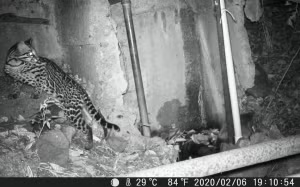


Anyone who goes to the Taboga Forest Reserve knows that it’s a special place. Sure, for some people it may be difficult to see that while you are there (what with the mosquitoes, snakes, mysterious rashes, and the fact that you are always sweating), but once you leave, it’s the fond memories that persist and outshine the others. People who have spent extensive time on the reserve will recall special little anecdotes, facts, or monkey stories that end up making them miss spending twelve hours fighting off clouds of mosquitoes and flicking ticks off of their pants. Herpetology enthusiasts will remember the myriad lizards and snakes, birders will remember the parrots and motmots, and everyone will remember the bevy of cool mammals that they were fortunate enough to see. Those who spend considerable time in Taboga invariably leave having seen something amazing or unexpected or memorable. As a result of all these animal observations, a good collection of stories began to accumulate about what might be out there in the forest. The speculation (often based on glimpses of tails or days-old paw prints left in dried mud) continued to the point that we just had to take the time to try to find out what kind of critters call Taboga home.
Fortunately for us, two students from the Universidad Técnica Nacional (UTN) had expressed interest in working with us. Anderson Eduardo Molina Jirón and Bryan Steven Zúñiga Cerdas took on the important task of using camera traps to set up an eight week long project in order to determine what habitats were able to support the most wildlife. By placing camera traps in various parts of the reserve, they were also able to see what Taboga actually had to offer in terms of fauna.
When their two months working with us were up, they had captured 25 different animal species on the camera traps. There were 2 reptiles, 11 birds, and 12 mammals. 25 species is by no means a large number for a tropical forest, but given the amount of time they had and the species that they captured, it was enlightening.
The biggest realization to come from this project was the fact that there was a very real and active presence of at least one puma (Puma concolor) on the reserve. It seemed like almost every week they put the cameras out they captured a puma. The photos were taken both during the day and the night and sometimes in locations very close to where we had been with the monkeys not an hour before. They were captured in a variety of different habitats and all across the reserve as well, leading us to believe that there was more than one out there (a real life sighting of two pumas together a couple of weeks later confirmed this suspicion). The fifteen or so photos of pumas that were captured backed up a story that long time monero Juan Carlos had told of seeing one near the Palmichal while he was alone one evening. While I don’t think anyone doubted him, it was nice to have his story verified by photographic proof.
The immediate question was why there were multiple big cats in such a diminutive (less than 300 hectares) and isolated forest fragment. What’s more, this fragment has been adrift in a sea of sugar cane and rice fields for decades. In thinking about how to answer this question, we remembered the many days when we would go out into the field and see 50+ coatis in just a couple of hours or the time spent on the computer sorting through thousands of collared peccary camera trap photos and the answer became clear: there’s plenty of food.
This abundance of food (i.e. small to medium sized mammals) also provides sustenance for other predators. Through camera traps and personal observations, we have also recorded the presence of ocelots, jaguarundis, tayras, greater grisons, crocodiles, rattlesnakes, boa constrictors, and many avian predators. This is, of course, not an exhaustive list and there are many other animals out there that I haven’t included and perhaps even more that we haven’t even seen yet.
In short, what the students’ project helped to reveal to us was an even more extensive and vibrant ecosystem than we had previously imagined. We all knew that Taboga was special, but now we begin to see just how important it is. Bryan and Anderson note in their paper that there is less than two percent of Central American tropical dry forest remaining and, while it makes up just a fraction of that two percent, Taboga clearly has a lot to offer in the way of animals. Researchers on the Capuchins at Taboga project have been keeping lists of all the fauna species they have observed in their short time there and have been wowed at the overall diversity and at the presence of animals like pumas and giant crocodiles, which we believed might not be able to survive in a reserve as small as Taboga. As Juan Carlos Ordoñez once casually noted after seeing an ocelot on the road just after nightfall: “que reservilla”, or in English: “what a little reserve”.
Here is a list of what Anderson and Bryan were able to capture on camera for their two-month project:
Reptiles:
American Crocodile
Green Iguana
Birds:
Groove-billed Ani
Inca Dove
White-tipped Dove
Dusky-capped Flycatcher
Gray Hawk
Cattle Egret
Bare-throated Tiger-Heron
Great Blue Heron
Anhinga
Limpkin
Black Vulture
Mammals:
Ocelot
Puma
Collared Peccary
Central American Agouti
White-nosed Coati
Northern Tamandua
White-tailed Deer
White-faced Capuchin Monkey
Common Opossum
Mexican Mouse Opossum
Nine-banded Armadillo
Eastern Cottontail
By Evan Farese